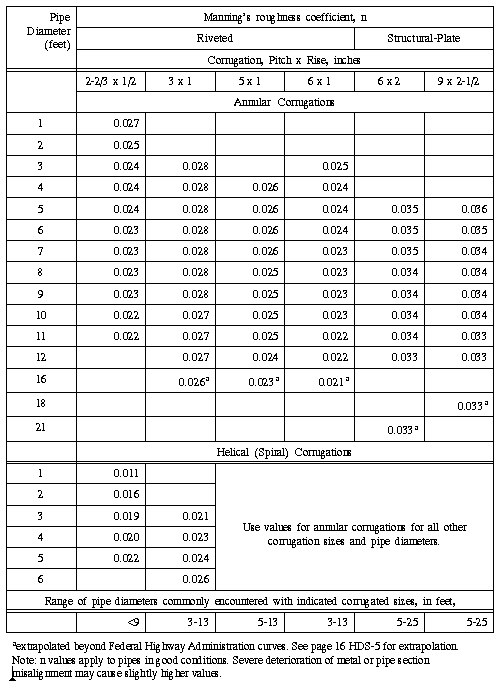TWRI 3-A3.--ERRATA
page viii, right column, for symbol n: Change ".. roughness of coefficient .." to ".. roughness coefficient".
page 19, table 4: On second line, for d/D equal to 0.02, change values in column 1 to 0.027, column 2 to 0.043, and column 4 to 0.043. On sixth line, value of d/D should be 0.06.
page 10, per OSW Technical Memorandum No. 93.17, replace sections on corrugated metal, and muliplate sections to:
Corrugated Metal
Corrugated pipes and arches are made in riveted, spiral and structural-plate styles. The riveted and spiral styles are used in small pipes of less than 9-foot diameter. Spiral corrugations have the same pitch and depth as that used in riveted construction, but the plates are wound to form a continuous pipe. Because of its greater strength, structural-plate (also called multiplate) commonly is used for pipes that are more than 6 feet in diameter. Multiplate is made in sheets that are bolted together.
Standard riveted sections
The corrugated metal most commonly used in riveted pipes and arches has a 2 2/3 inch pitch with a rise of 1/2 inch. This is frequently referred to as standard corrugated metal. According to laboratory tests, n values for full pipe flow vary for 0.0266 for a 1-foot diameter pipe to 0.0224 fro and 8-foot diameter pipe for velocities normally encountered in culverts. The American Iron and Steel Institute recommends that a single value of 0.024 be used in design of both partly-full and full-pipe flow for any size of pipe. This value may be satisfactory for many computations of discharge. However, more precise values are given in the accompanying table, which shows values derived from tables and graphs published by the Federal Highway Administration for culvert design and that apply to both annular and spiral corrugations, as noted in the table. Values from this table should be used by U.S. Geological Survey offices in computation of discharge through culverts.
Riveted pipes are also made from corrugated metal with a 1-inch rise and
3-, 5-, and 6-inch pitch. Experimental data show a slight lowering of
the n value as pitch increases. The n values for these three types of
corrugation are also given in the table.
Helical corrugated pipe
Standard corrugated helical pipe is formed from a 24-inch wide strip of
steel. Tests on helically corrugated pipe indicate a lower coefficient
of roughness than for annualarly corrugated steel pipe. Roughness
values for helical corrugated pipe are listed in the accompanying table
and are based on American Iron and Steel Institute recommendations.
Structural Plate (Multiplate)
Structural-plate metal used in multiplate construction has much larger corrugations than does that used in riveted pipes. Multiplate construction is used with both steel and aluminum. The steel has a 6-inch pitch and a 2-inch rise; aluminum has a 9-inch pitch and a 2.5-inch rise. Tests show somewhat higher n values for this metal and type of construction than for riveted construction. Average n values range from 0.035 (steel) or 0.036 (aluminum) for 5-foot diameter pipes to 0.033 for pipes of 18 feet or greater diameter. The n values for various diameters of pipe are given in the following table:
 page 26, Figure 11, Vertical axis label: Denominator should contain Rc instead of R.
page 60, Selected References: Add the following: Normann, J.N., 1980, Hydraulic flow resistance factors for corrugated metal conduits: Federal Highway Administration Report No. FHWA-TS-80-216, 36 p.
page 26, Figure 11, Vertical axis label: Denominator should contain Rc instead of R.
page 60, Selected References: Add the following: Normann, J.N., 1980, Hydraulic flow resistance factors for corrugated metal conduits: Federal Highway Administration Report No. FHWA-TS-80-216, 36 p.

